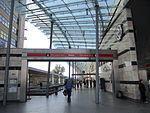Kőbánya
Kőbánya

Kőbánya (literally: Quarry, German: Steinbruch) is the 10th district of Budapest (Hungarian: Budapest X. kerülete) and one of the largest by territory. It is located in southeast Pest, easily accessible from the downtown by Metro 3, whose terminus is named Kőbánya-Kispest. It has strong industrial and organized labour traditions; as such, it suffered a decline after the collapse of the Hungarian People's Republic in 1989–90. Today, the district is rebuilding itself into a living area for the middle class. Due to its large size, there are several diverse areas within Kőbánya, each with different architecture.
Excerpt from the Wikipedia article Kőbánya (License: CC BY-SA 3.0, Authors, Images).Kőbánya
Szlávy utca, Budapest Külső Kőbánya
Geographical coordinates (GPS) Address Nearby Places Show on map
Geographical coordinates (GPS)
| Latitude | Longitude |
|---|---|
| N 47.476388888889 ° | E 19.143055555556 ° |
Address
Szlávy utca 49/A
1104 Budapest, Külső Kőbánya
Hungary
Open on Google Maps









